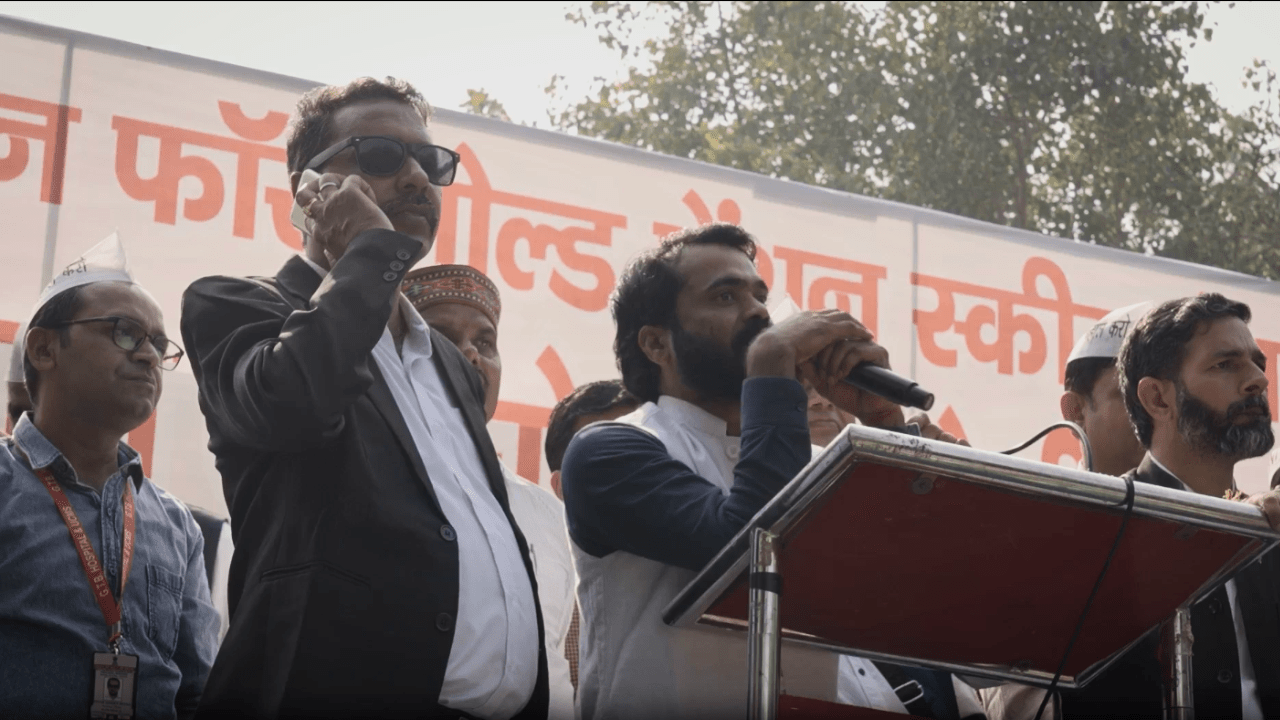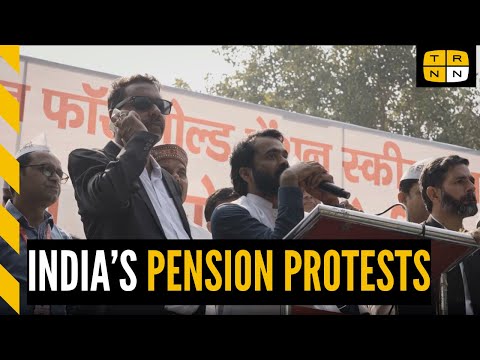Several thousand government workers are on the streets of India demanding restoration of the old pension structure. The new structure has no fixed pensions. The movement that was going on for nearly a decade grew phenomenally across the country last year with multiple opposition leaders expressing their support. There were many protest events in New Delhi, the national capital, in the last few months of 2023. With the ruling Bharatiya Janata Party government showing no interest in going back to a fixed pension model, the protests continue to grow. As Manjneek Kaur of the National Movement For Old Pension says, “Till we achieve our goal this struggle will continue again and again. Be it in the form of rallies, localised protests or in any other form.” TRNN contributor and video journalist Dipanjan Sinha reports from the streets of New Delhi.
This story, with the support of the Bertha Foundation, is part of The Real News Network’s Workers of the World series, telling the stories of workers around the globe
Producer, Translator, Editor: Dipanjan Sinha
Videographer, Editor: Mohit Sauda
Transcript
Manjeet Singh Patel, president, National Movement for Old Pension: If the movement is on, we will get back the old pension. Right here, from Delhi.
Dipanjan Sinha (narrator): Workers from central and state governments of India have been protesting India’s new pension scheme for years now.
Workers sloganeering: We want pension
Minsters are taking pension and giving us tension
Samay Singh Meena, government school teacher: There 85 lakh government employees who are not getting pensions (the older pension), whereas the MPs and MLAs are getting four or five older pensions.
Pema Bhutia, president, National Movement for Old Pension (Sikkim state): We have appealed multiple times for the older pension scheme. We told them that we are not (financially) secure after retirement but they don’t listen to us.
Dipanjan Sinha (narrator): This year, the movement has gained momentum with multiple state governments declaring their support for the old pension structure.
Manjeet Singh Patel, president, National Movement for Old Pension: Every person gathered here has just one wish that their security for old age, their pension be given to them. Apart from this we have no other agenda.
Manjeet Singh Patel, president, National Movement for Old Pension: People who were in jobs earlier, before NPS, before 2004, used to have qualifying service years. Central government employees had a qualifying service of 10 years.
So if you joined and completed 10 years, after that you retire anytime. Say you joined a service at 50 and retired at 60, you would start getting a pension that is half of your last drawn salary and dearness allowance. You keep getting a pension in this pattern till you are alive.
Every 10 years there is a pay commission. This pay commission restructures the salary. The salary doubles trebles or increases by whatever factor. And just the way the salary increases, pension increases the same way.
So now the government has done away with that system under the NPS (new pension scheme). The people joining jobs (after 2004) have 10 percent of their basic salary and dearness allowance deducted every month.
Dipanjan Sinha (narrator): Under the new pension scheme, there are two contributions made to the pension fund. One from the employee’s salary and the other from the government. This fund is then invested in the market.
When the employee retires, the accumulated fund which has grown in the market is used to pay the employee’s pension. This subjects pension funds to the ups and downs of the market, which means there is no guarantee of a fixed pension amount like earlier.
Workers sloganeering: One demand, one slogan. OPS is our right.
Manjneek Kaur, president, All-India NPS Employee Federation, Chandigarh: Working women have obviously helped in the democratisation of the society. To come out of their houses women need jobs.
Right now, the thing is, when we are talking about security, men have paternal properties, they can own so many things from their paternal homes. For women, though legally we can inherit our parent’s house, but if we check the data on the ground, less than 1 percent of women own properties in this country.
So for their future, pension and government jobs play a very important role.
Especially in cases of widows or single mothers, the pension amount becomes very helpful in their old age. It is because of this amount that they can live well into their old age.
Pema Bhutia, president, National Movement for Old Pension (Sikkim state): Now when we will retire, with only 6 percent we will get around Rs 500 to 1400 on average. In our service, around 1200 employees have retired and they get a pension of as low as Rs 1400. This is why NPS is not secure.
Manjeet Singh Patel, president, National Movement for Old Pension: Consider this, each bank gets Rs 4,000 crore every month. (pension money) They invest this money in the market and run their business. If NPS is stopped, they will stop getting this amount.
Secondly, the 10 lakh crore that has been invested in the market will also need to be pulled back. So the market forces, the corporate sector, the bankers are putting pressure on the government to not withdraw the NPS scheme.
This is one important reason; otherwise perhaps we would not need to do so many protests. At some level there is a lot of influence from the corporations on the government.
Dipanjan Sinha (narrator): In the last few months, the country saw rallies and sporadic strikes of several thousand workers in different states and the national capital.
The workers are demanding restoration of the old pension scheme. This entitles an employee to a pension equal to 50 per cent of their last drawn salary. According to them, even at the highest, the new pension equals barely 20 percent of the last salary.
Manjeet Singh Patel, president, National Movement for Old Pension: So we started looking for affected people in different states. People who were motivated and aware. There were some people already working on this in Himachal Pradesh, in Punjab, in UP (Uttar Pradesh), Karnataka, Andhra, Telangana, Maharashtra, Haryana…so we all got together and gave it the shape of a national movement.
On April 30, 2018, we all came together and organised our first rally in Ramlila Maidan (Delhi).
Dipanjan Sinha (narrator): In 2018, chief minister of Delhi, Arvind Kejriwal, came out in support of the old pension scheme. Though this did not mean much technically, it was a great morale booster for the movement across the country. Since then chief ministers of multiple states have come out in support of the old pension scheme.
Yogen Tamang, forest department, Sikkim: From today, from this rally, we are hoping that soon we will get a positive news from our central government.
Dipanjan Sinha (narrator): The goal of the movement now is an assured pension for every worker. They want to go back to the older pension scheme under which every government employee got a pension which was 50 per cent of their last drawn salary and an additional dearness allowance for the rest of their lives.
The protests have led to the union finance ministry setting up a committee in April this year to suggest improvements.
Manjneek Kaur, president, All-India NPS Employee Federation, Chandigarh: Till we achieve our goal this struggle will continue again and again. Be it in the form of rallies, localised protests or in any other form. We just want one thing and that is an assured pension and till we achieve that we will continue our struggle.
Dipanjan Sinha (narrator): While the report is yet to come, the central government has ruled out the possibility of going back to the earlier scheme. The protests, however, continue to grow.




